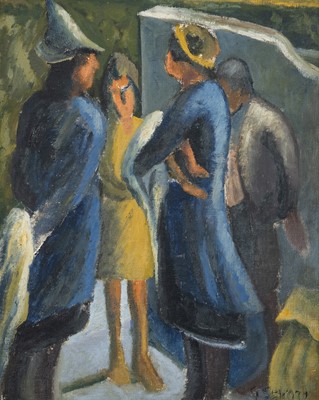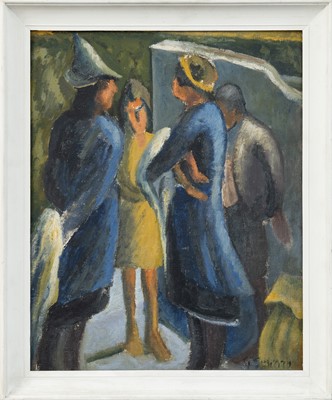13th Sep, 2023 18:00
20th Century & Contemporary Art
46
Gerard Sekoto (South Africa 1913-1993)
Street Corner
oil on board
Artwork date: c. 1942-45
Signature details: signed bottom right; inscribed with the artist's name and the title and adhered with an M. Wolpe framers sticker on the reverse
Sold for R892,000
Estimated at R800,000 - R1,200,000
Condition Report
The overall condition is good.
Water damage from the past when viewed from the reverse. Board is well adhered with a medium-weight tabby weave canvas with a slight turn-over edge.
There is no surface dirt present. The painting is not varnished.
Please note, we are not qualified conservators and these reports give our opinion as to the general condition of the works. We advise that bidders view the lots in person to satisfy themselves with the condition of prospective purchases.
oil on board
Artwork date: c. 1942-45
Signature details: signed bottom right; inscribed with the artist's name and the title and adhered with an M. Wolpe framers sticker on the reverse
(1)
49 x 39 cm; framed size: 57 x 48 x 2.5 cm
Provenance:
Private collection Cape Town.
Acquired by the late Advocate Gerald Gordon, from Max Wolpe Senior, in the early 1970s.
ABOUT THE ARTWORK
Early paintings such as this gem by celebrated artist Gerard Sekoto rarely come to market. And seldom do they have such impeccable provenance. As affirmed in the notes on the reverse of the painting, the work was acquired directly from the framing company of Max Wolpe senior, father of the incomparable connoisseur and beloved art dealer, Joe Wolpe.
Sekoto’s extraordinary talent as an artist was recognised at a very early stage in his career. His paintings stood out even within the ground-breaking New Group. An influential and progressive artist’s group founded in 1937, early members included Gregoire Boonzaire, Lippy Lipshitz and Freida Lock in the Cape and Walter Battiss, in what was then the Transvaal. The group fast gained critical appreciation and, according to The Cape Argus, a leading source of art criticism and appreciation at the time in a 1940 New Group exhibition, Sekoto showed, “work of independence and much promise”.[1] What is noteworthy is the critic’s favourable impression of the artist in that Sekoto is discussed third, after Alexis Preller and Harry Trevor. In the context of both the social milieu and the art scene of the 1940s, this is particularly remarkable.
Similarly, a critic in The Cape Times noted that his canvases were good enough to attract favourable attention in their own right “next to a hundred others by 20 of the Union’s best painters”. He goes on to observe: “His pictures, mostly in strong colours, purples, reds and yellows, but sometimes delicately toned in pearly greys – are of street scenes, people around huts or women drawing water. They fetch anywhere between 15 and 40 guineas each.”
Sekoto moved to District Six in 1942 and this is one of his earliest urban subjects. In Street Corner, he has chosen to depict a meeting at night on a street corner between friends or perhaps, a gathering of comrades. The 1940s were characterised by changes that had a profound effect on the political landscape in South Africa and District Six was at the heart of political foment. Cissie Gool, a local resident and an anti-apartheid political and civil rights leader, became the president of the Non-European United Front (NEUF) in 1940 [2]. One can imagine the influence of such political activism on the young Sekoto and how he may have been inspired to capture something of it for posterity.
Street Corner reveals evidence of his early mastery of the medium of oil paint in the atmospheric effects employed to convey the mood of the occasion. With painterly skill and an intuitive understanding of human relations, Sekoto captures this small group huddled together to exchange views.
It may also have been the sheer intimacy of a group of adults gathering together while a mother rocks her child to sleep that caught the artist’s eye. An intuitive understanding of human relations and a sincere empathy with his fellow human beings, allowed Sekoto to explore the nature of the scene which might equally have been an occasion to discuss the issues of the day. Either way, this gathering of people to share views on the day’s developments or help soothe a child to sleep, is one of profound humanity, for which Sekoto is rightfully celebrated.
Emma Bedford
[1] ERP. Artists Break with Tradition, The Cape Argus, South African National Gallery Press Cutting book E1(b), p.12, dated 10.6.40.
[2] Liberation History Timeline 1940-1949. Available at: https://www.sahistory.org.za/article/liberation-history-timeline-1940-1949 (Accessed: 10 August 2023).
COLLECTOR'S NOTE
The painting is evidence of the artist’s growing artistic confidence during the early 1940s which is also visible in other important works from the period such as Evening in the Corner (1942/43) from the Homestead Collection and recently exhibited in When We See Us at Zeitz MOCAA in Cape Town, Basking (c.1942) which is in the collection of the Iziko South African National Gallery, Street Bonhomie, District Six (c. 1944) from the Johannesburg Art Gallery collection, and Yellow Houses, District Six (1942) which sold at Bonhams in London in 2011 for a record-breaking GBP 602 400.
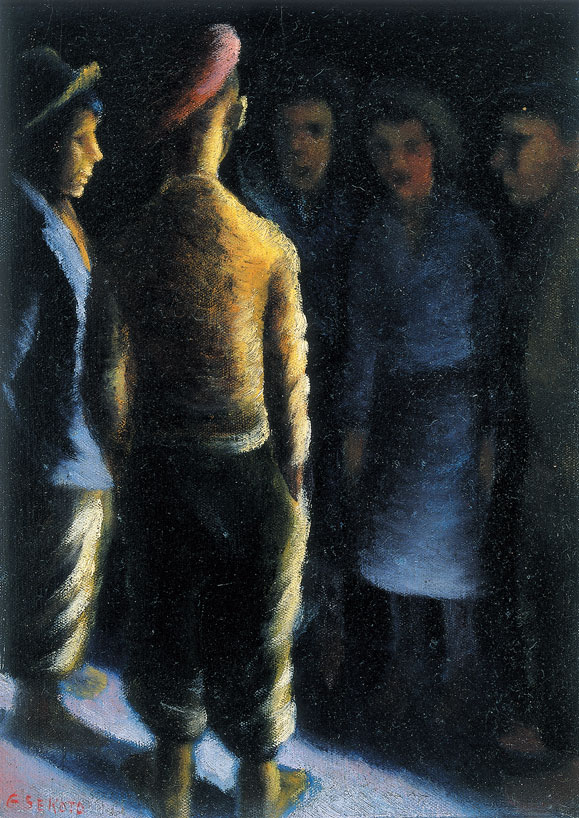
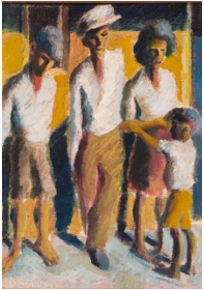
LEFT | Gerard Sekoto, Street Bonhomie, District Six, c.1944, Johannesburg Art Gallery.
RIGHT | Gerard Sekoto, Basking, c.1942, Iziko South African National Gallery.

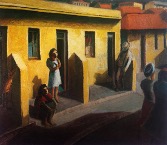
LEFT | Gerard Sekoto, Street Bonhomie, District Six, c.1944, Johannesburg Art Gallery.
RIGHT | Gerard Sekoto, Yellow Houses District Six, 1942, sold with Bonham's for GBP 602 400 in 2011.
COLLECTIONS
The artist is represented in numerous local and international collections, notably:
Municipal Collection of the City of Paris.; Several works acquired by President Leopold Senghor -exhibited in the Presidential Palace in Senegal; Gallery Guildhall, Chicago; La Ville de Paris.; The Nedbank Art Collection South Africa.; SABC Corporation Art Collection South Africa.; The MTN Art Collection, South Africa.; The South African Reserve Bank Collection, Johannesburg.; The Sanlam Art Collection Johannesburg.; Standard Bank Collection Johannesburg.; Johannesburg Art Gallery, Johannesburg.; Javett Art Centre, Pretoria.; Iziko South African National Gallery, Cape Town.; University of the Witwatersrand, Johannesburg.; University of Fort Hare, Alice.; UNISA, Pretoria.; William Humphreys Art Gallery, Kimberley.
You can place an absentee bid through our website - please sign in to your account on our website to proceed.
In the My Account tab you can also enter telephone bids, or email bids@aspireart.net to log telephone/absentee bids.
Join us on the day of the auction to follow and bid in real-time.
The auction will be live-streamed with an audio-visual feed.
Auction: 20th Century & Contemporary Art, 13th Sep, 2023
Currency conversions are based on the exchange rate at the auction's start time and date. Bidders should verify the current exchange rate on the day of the sale. All invoices and payments must be made in South African Rands.
IMPORTANT NOTICE:
Logistics
While we endeavour to assist our Clients as much as possible, we require artwork(s) to be delivered and/or collected from our premises by the Client. In instances where a Client is unable to deliver or collect artwork(s), Aspire staff is available to assist in this process by outsourcing the services to one of our preferred Service Providers. The cost for this will be for the Client’s account, with an additional Handling Fee of 15% charged on top of the Service Provider’s invoice.
Aspire Art provides inter-company transfer services for its Clients between Johannesburg and Cape Town branches. These are based on the size of the artwork(s), and charged as follows:
Small (≤60x90x10 cm): R480
Medium (≤90x120x15 cm): R960
Large (≤120x150x20 cm): R1,440
Over-size: Special quote
Should artwork(s) be collected or delivered to/from Clients by Aspire Art directly, the following charges will apply:
Collection/delivery ≤20km: R400
Collection/delivery 20km>R800≤50km
Collection/delivery >50km: Special quote
Packaging
A flat fee of R100 will be added to the invoice for packaging of unframed works on paper.
International Collectors Shipping Package
For collectors based outside South Africa who purchase regularly from Aspire Art’s auctions in South Africa, it does not make sense to ship artworks individually or per auction and pay shipping every time you buy another work. Consequently, we have developed a special collectors’ shipping package to assist in reducing shipping costs and the constant demands of logistics arrangements.
For buyers from outside South Africa, we will keep the artworks you have purchased in storage during the year and then ship all the works you have acquired during the year together, so the shipping costs are reduced. At the end of the annual period, we will source various quotes to get you the best price, and ship all your artworks to your desired address at once.
Aspire Art will arrange suitable storage during, and cost-effective shipping at the end, of the annual period.
Collections
Collections are by appointment, with 24-hours’ notice
Clients are requested to contact the relevant office and inform Aspire Art of which artwork(s) they would like to collect, and allow a 24-hour window for Aspire Art’s logistics department to retrieve the artwork(s) and prepare them for collection.
Handling Fee
Aspire Art charges a 15% Handling Fee on all Logistics, Framing, Restoration and Conservation arranged by Aspire.
